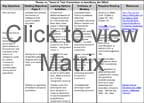Weekly Objectives
In this week you will...
- explain how gifted characteristics impact the referral process in your district.
- describe the criteria your district uses for gifted eligibility and placement.
- examine traditional and alternative assessment instruments and techniques used in your district to screen and identify students who are gifted.
- explain how identification criteria is used to determine appropriate gifted programming.
- examine the components of the Educational Plan (EP) to understand what is required when creating EPs for gifted students.
- explore resources to assist in writing quality EPs.
Screening and Identification
You are about to enter the world of paperwork! We are living in a time of documentation and accountability. The journey of the gifted child, from referral to identification to placement requires a specific paper trail. This week you will take this journey and learn about the types of documents and the necessary information needed to fill them out accurately.
The world of the gifted also necessitates a strong communication connection between school, student, and parent. The required teacher/parent conference(s) is expanded to a formal meeting involving the parent, teacher, LEA (local educational agency) representative,ESE specialist or other qualified administrator, school psychologist, and, even the student at times. You will have the opportunity to “sit in” on a review meeting for a child who has been in a gifted program for two years and observe the roles of all the major players.
Screening —The Process Begins
Based on specific criteria, we have sent our list of referrals for the gifted program to the appropriate person(s) or committee in our school. (This will vary district to district, school to school.) Now the “fun” begins. The process is actively set in motion.
No matter where you teach, paperwork must be completed, sent home, and signed! As always, federal, state, and local policies dictate the information required on the forms, the appearance of the forms, and the length of their validity period.
How are students screened? Is screening different from testing? What pieces of information are gathered each step of the way? These are questions that continue to have very diverse answers, depending on where you teach. A good resource for you to read, as well as to share with parents, is the NAGC website. Generally, after the child has been referred for the gifted program, paperwork is sent home to the parents to obtain information about the child’s health, development, study habits, hobbies, etc. When these papers are completed, signed, and returned, the child is scheduled for a preliminary screening test. This test is often administered to individual students by the LEA representative or any other professional (including teachers) on staff trained on the particular protocol. The selected tests vary, but most look at academic performance and the potential for higher levels of thinking and abstract reasoning.
In some districts there is a trend towards universal screening. Tests such as the Naglieri or Otis Lennon Mental Ability Test are administered to large groups (either by referral or general grade level) of students. Those scoring above the established baseline and, in some cases, meeting other specific criteria, will then be referred for the next set of tests.

